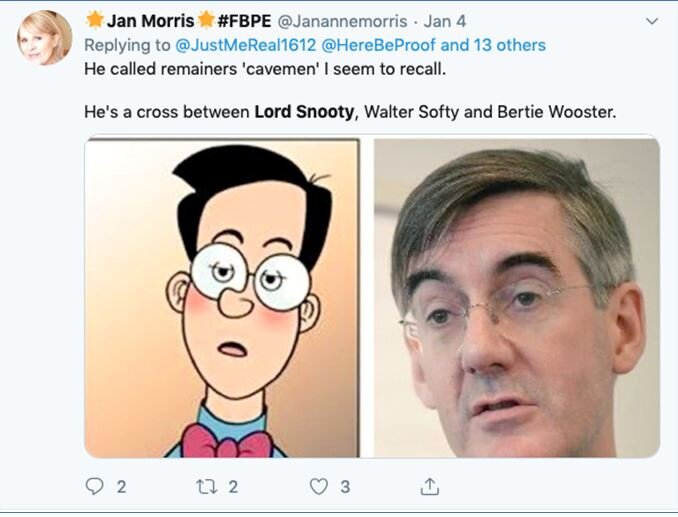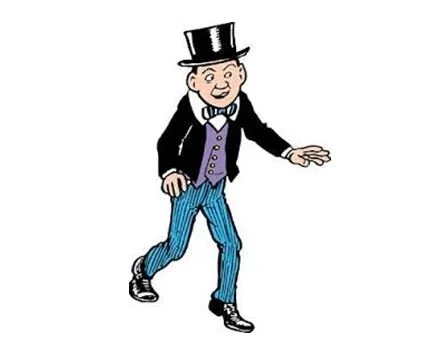'The Beano's' Lord Snooty (Part 4 of 4) by Dave Miller
/Cartoonish toffs, memes & use of Beano characters to criticise political power
For a couple of decades discourses of class became unpopular. In Britain the divisive labour struggles of the Thatcher era had ended and in 1990 John Major announced his plans to make the whole country a genuinely classless society. When New Labour came to power in 1997, Tony Blair declared the class war was over, and talked instead about combating social exclusion and increasing social mobility.
But in actual fact, the class war merely changed form. Richard Hoggart, the author and academic famously said that "Class distinctions do not die; they merely learn new ways of expressing themselves." This is as true now as it was 25 years ago, and 25 years before that. "Each decade," he continued, "we shiftily declare we have buried class; each decade the coffin stays empty".
Jacob Rees Mogg, aged 13
The Huffington Post’s Alex MacDonald argues that the Occupy Movement in 2008, with the 99% campaign, highlighted that the UK class divide is not shrinking, but is in fact bigger than any time since World War II. Yet the Diamond Jubilee celebrations in 2012 highlighted a total lack of class awareness, with its huge popularity and the register of approval for the Monarchy and Wartime nostalgia that came with it. The Jubilee was an immense spectacle of privilege, wealth and hereditary superiority, and the public loved it. Boris Johnson was elected Mayor of London (and now Prime Minister) based on his cartoonish toffery, a self-parody of his own immense wealth and privilege - and again the public lapped it up. Since 2008 Britain has had a cabinet of millionaires - Cameron, Osborne, Johnson, Mogg - all belonging to an Etonian mafia, Oxbridge, Bullingdon Club heritage which almost guarantees them power. How much of this popularity comes from a British attitude of deference to class superiority and poshness?
Cartoonish buffoony - Boris Johnson dangling from zip wire (Daily Mail, 2012)
Paul Mason in the New Statesman argues that “Politics, for Johnson and the entire clan surrounding him, has become a form of showing off - and that Conservative politics has become not just a game for privileged people, but a kind of catwalk on which they can display their egos”.
Bizarrely, this showing off seems to involve these aristocratic politicians modelling themselves on comic book English toffs. For example, in 2012, referring to Andrew Mitchell, the former chief whip, and George Osborne, the Chancellor, Alex Salmond asked the SNP conference: “Why on earth do we allow this bunch of incompetent Lord Snooty’s to be in positions of authority over our country?”. In 2017, the TUC boss Frances O’Grady likened the top Tories to Beano characters Lord Snooty, and Snitch and Snatch. She labelled Boris Johnson as posh Earl Lord Snooty, and Liam Fox and Michael Gove as like Snitch and Snatch .
How intentional is this adopting of comic personas, or is it mere coincidence? Just how much have politicians been influenced by Beano and Dandy comic characters? Is this a case of life imitating art? Is it even a form of Cosplay? Quite possibly the politicians play up to the comparisons with comic book characters?
Politicians adopting Beano and Dandy personas
As well as politicians adopting the personas, Beano and Dandy characters are also being used as ways to criticize political power. They are easy to use - distinctively British, familiar to a certain generation (though probably not with young generations as less familiar with the comics), deeply rooted in British culture, very strong associations, instantly recognizable.
This demonstrates that the Beano and Dandy are no longer just kid’s comics - their characters (and background stories, sometimes distorted) have become ideological and political instruments – as Lord Snooty has been for generations, as a commonly used insult. In this way Lord Snooty is no longer just a comic character or an insult, he’s a vehicle for political argument, even a weapon.
Rah Rah Rah We’re going to smash the Oiks! (Lord Snooty Meme, 2019)
Mogg is a fake Lord Snooty – Twitter (@communicipalist, 2019)
Politicians have used (Beano and Dandy) cartoon insults and comparisons as a (cheap) way to attack the opposition and tap into the civic imagination. In essence, a popular children’s comic is being adopted and adapted for political ends. In recent years, memes have been employed and deployed by audiences on the left and the right, becoming effective weapons in the new culture wars (such as Trump followers did with Pepe the Frog).
Boris Johnson has been accused of cynically constructing his identity in order to gain power. His identity seems to be a mixture of Beano comic characters, Bertie Wooster and Billy Bunter, but most likely the cheeky and mischievous Lord Snooty. As Hitchings et al puts it: “Johnson favours a passé form of exclamation that makes him seem unthreatening. Every time he says ‘Cripes,’ it calls to mind a short-trousered scamp who has just set aside his slingshot in order to inspect a mysteriously broken window. It’s a powerful archetype in English children’s literature, from Dennis the Menace to Just William.”
In The Telegraph newspaper —often described as the ‘Torygraph’ by the left — Moore wrote an article in 2009 on the then-Leader of the Opposition, David Cameron comparing him to the idea of Lord Snooty, a ‘toff’ befriending the poor, and argued that Lord Snooty was the ideal role model for him. However, they questioned whether Cameron was the first version of Lord Snooty, or the nasty Lord Snooty III (Moore, 2019).
Rees Mogg is regularly compared to Lord Snooty.
Mogg is also frequently compared to ‘Walter the Softy’ - a popular character from ‘Dennis the Menace’ cartoon in the Beano. Walter the Softy is frequently pranked by Dennis the Menace and his trusted dog and sidekick Gnasher.
In April 2018 (to mark their 80th anniversary) the Beano comic even issued a (tongue in cheek) cease-and-desist letter to Mogg, claiming he has modeled himself on its character Walter the Softy. DC Thomson accused the Tory MP of “masquerading” as Walter Brown, a foe of Dennis the Menace. It listed traits including his side parting, round glasses and “snootiness” as “distinctly copying” the character.
In the letter, addressed to the North East Somerset MP at the House of Commons, Mike Stirling, head of Beano Studios Scotland, said Mr Rees-Mogg had been "infringing the intellectual property rights of one of our cartoon characters". He said it was "evident there are numerous instances whereby you have adopted trademarked imagery and brand essences of the character to the benefit of enhancing your career and popularity".
Cease and desist letter to Rees Mogg (Daily Mail, 2018)
Mike Stirling, head of Beano Studios Scotland, said: “We were flattered when we discovered that Jacob Rees-Mogg has dedicated his life to impersonating one of my favourite Beano characters, young Walter”.
Rees-Mogg reacted light-heartedly to the humorous legal letter, denying he was doing this and claims he has more admiration for PG Wodehouse characters … “I did read the Beano as a child but I never thought I'd model myself on Walter the Softy.” Addressing the specific allegations in the letter, Mr Rees-Mogg insisted that he was “in favour of other people having fun” and said “snootiness is really rather unpleasant.”
Conclusion
Lord Snooty started out in 1938 as a strip in the kid’s comic The Beano. The strip taps into the humour of class difference and the idea of a lovable anarchic aristocrat who poked fun at the bourgeoise establishment, as the character joined forces in solidarity with his working class friends, to rebel against the establishment that he himself was part of.
The Beano and Dandy comics were created during the 1930’s Great Depression, and reflected and commented on the social hardship of daily life at that time. Lord Snooty is a strip that taps into class differences with a comedic, satirical bent.
Over the years the Lord Snooty comic and character has become part of common language usage. For generations it has been used as an insult and slur against someone posh, snobby, aloof, who looks down on people - which is actually a gross distortion of the original story and character. More recently still, some Conservative Party politicians have adopted the Lord Snooty persona (as well as other Beano and Dandy comic personas) and have started looking and behaving in daily life like those comic characters.
At the same time, Beano characters are being used to criticise political power. This is happening in Parliament, in the newspaper media, and especially in Internet memes. Beano characters are being adopted by audiences to use as memetic warfare, and the Lord Snooty meme is a good example of this.
These popular Beano characters are much more than last century’s comics: they have become ideological and political weapons in the digital age.
Dave Miller is a designer and artist who makes mostly satirical works through combinations of comics, graphic novels, interactive and non-linear storytelling, especially in the context of computation, the Internet and emerging media. He has taught courses in both Design and Interactive Media at London South Bank University and Bournemouth University. He currently works at the Cartoon Museum in London, and is writing a political graphic novel. This is his first writing about comics.
The ‘Remembering UK Comics’ series is curated and edited by Dr William Proctor and Dr Julia Round, both of whom are Principal Academics at Bournemouth University, Dorset, UK.































































































